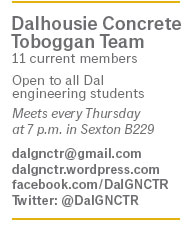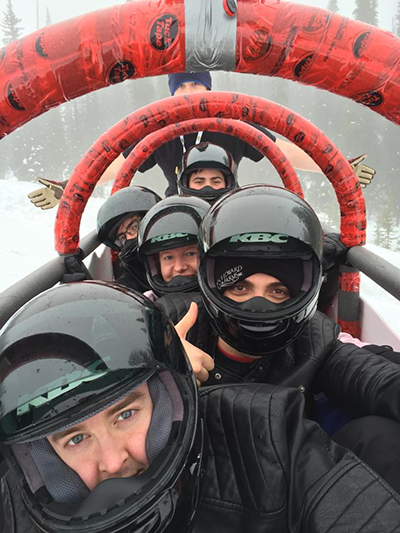 Remember the thrill of racing down a snow-covered hill on your old wooden toboggan or cheap plastic sled? The snow spraying in your face as you hurtled down, hoping you’d make it to the bottom before wiping out in spectacular fashion? Now imagine doing it in an almost 300-lb beast made of concrete and metal. That’s what the does for fun—and school pride.
Remember the thrill of racing down a snow-covered hill on your old wooden toboggan or cheap plastic sled? The snow spraying in your face as you hurtled down, hoping you’d make it to the bottom before wiping out in spectacular fashion? Now imagine doing it in an almost 300-lb beast made of concrete and metal. That’s what the does for fun—and school pride.
In late January, nine of the 11 team members travelled to Big White Ski Resort in Kelowna, B.C. to compete against 16 other crews in the (GNCTR), an annual tradition for Canadian engineering students. Established in 1975, the competition is a chance for students to test practical applications of theories they’ve learned in class, as well as to meet other budding engineers from across the country (and sometimes the U.S.).
“It’s mostly civil and mechanical engineering students, but all engineers can join. I’m in environmental,” says team member Ellen Patrick. “When most people hear ‘concrete toboggan’ they think we’re going down a concrete hill on a normal toboggan.”
But that’s not the case. The toboggan itself is made partially of concrete, and the team takes it down a snow-covered hill, all while adhering to a strict set of rules. “The running surface of the toboggan is concrete, so our skis are made out of concrete and the rest of it is aluminum,” says Patrick. “The mechanical engineers design the frame, and it has to have a steering system and a braking system. We’re judged on how fast it goes, how well it steers, and how fast it stops. It also has to weigh less than 300 pounds.”
Safety first
Ã˝
It seems like a recipe for disaster, especially considering the toboggans can get up to 80 km/h, depending on the conditions of the hill and the construction of the toboggan. Thankfully, there are safety measures in place to minimize the risk of disasters on the hill.
 “The sleds have to have a roll bar,” says Patrick. “They have to fit five people and they all have to be seated and contained within the structure. We did something called a finite element analysis to make sure that if there’s a crash, our toboggan wasn’t going to get crushed. There are no seatbelts, so when there are crashes, people just sort of fly off everywhere. We also wear helmets.”
“The sleds have to have a roll bar,” says Patrick. “They have to fit five people and they all have to be seated and contained within the structure. We did something called a finite element analysis to make sure that if there’s a crash, our toboggan wasn’t going to get crushed. There are no seatbelts, so when there are crashes, people just sort of fly off everywhere. We also wear helmets.”
Safety is just one of many things that is considered during the judging of the competition. In addition to the performance of the sled on the hill, teams also present a technical report detailing the process they followed to design and construct the toboggan, including braking, steering, and frame construction, as well as the sustainability of the materials used.
Once competition day arrives, there are a few different categories in which the teams compete. “Each team goes down the hill at least three times,” says Patrick. “One is called the Drag Race, where you’re timed for how quickly you get down and how quickly you brake. Then there’s the Slalom Run where you have to go between three gates and your braking is also timed. Lastly, there’s King of the Hill where you race against another team.”
Two teams go up against each other in each race, with the winner moving on to the next round until there's one winning team remaining. At this year’s competition, the Dal team beat the University of Waterloo in the first round, but then lost against the Southern Alberta Institute of Technology.
While the full competition results won’t be announced for a couple of weeks, the theoretical awards were presented at the competition. The Dal team took home third place for the design of its braking system.
The social part of competition
Ã˝
In addition to the design awards, team spirit and sportsmanship are integral parts of the experience. Each team chooses a theme for their uniforms and toboggan decoration. “Our theme was the musical Grease,” says Patrick. “The girls on the team were the Pink Ladies, and the guys had leather jackets and greased hair. There’s a judging category for team spirit, so you wear your costumes everywhere.”

Building a toboggan to enter in the GNCTR is a largely an exercise in teamwork and creativity. “There’s no book to follow,” says Patrick. “The collaboration between the different types of engineers is really important. You can’t build the frame unless you know how it’s going to fit on the skis. The mechanical engineers are really helpful because they know about that kind of thing, or else we might really be at a loss.”
Many tests and experiments are required to get the mix of the concrete and the design of the skis just right. The team spends months doing compression tests to see how much pressure a concrete ski can take, or how far it can bend before it will break. This year, the team created five different mixes of concrete and settled for the one that performed the best during the tests and would keep them under the 300-lb restriction. Then, to help really make the sled fly, ski wax was applied to the skis to reduce friction.
There’s a lot of trial and error involved, and even more time to get everything right. The test mixes of the concrete alone take many weeks to harden. It’s no wonder the team is going to start meeting soon to begin planning for next year’s big race.
Follow the progress of the ª∆…´÷±≤• Concrete Toboggan team on and .

